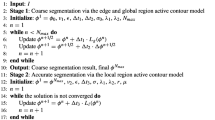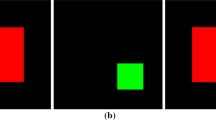Abstract
We propose an image segmentation model that is derived from reaction–diffusion equations and level set methods. In our model, a diffusion term is used for regularization of a level set function, and a reaction term has the desired sign property to force the level set function to move up or down and finally identify an object and its background. Our level set function can be initialized to any bounded function (e.g., a constant function). The proposed model can be applied to a wider range of images with promising results, especially for real images that have high noise and blurred boundaries. This study gives a new method for the further investigations of reaction–diffusion equations directly for segmentation.













Similar content being viewed by others
References
Aldo, M., Philippe, C., Bertrand, A., & Christine, F. M. (2008). Cooperation of the partial differential equation methods and the wavelet transform for the segmentation of multivalued images. Signal Processing: Image Communication, 23(1), 14–30.
Bini, A. A., & Bhat, M. S. (2014). Despeckling low SNR, low contrast ultrasound images via anisotropic level set diffusion. Multidimensional Systems and Signal Processing, 25, 41–65. doi:10.1007/s11045-012-0184-5.
Catte, F., Lions, P., Morel, J., & Coll, T. (1992). Image selective smoothing and edge detection by nonlinear diffusion. SIAM Journal on Numerical Analysis, 29, 182–193.
Chan, T., & Vese, L. (2001). Active contours without edges. IEEE Transactions on Image Processing, 10(2), 266–277.
Chen, Y., Vemuri, B., & Wang, L. (2000). Image denoising and segmentation via nonlinear diffusion. Computers and Mathematics Applications, 39, 131–149.
Chuang, K. S., Hzeng, H. L., Chen, S., Wu, J., & Chen, T. J. (2006). Fuzzy c-means clustering with spatial information for image segmentation. Computerized Medical Imaging and Graphics, 30, 9–15.
Crandall, R. (2009). Image segmentation using the Chan–Vese algorithm. ECE 532 Project, Fall.
Gao, G., Zhao, L., Zhang, J., Zhou, D., & Huang, J. (2008). A segmentation algorithm for SAR images based on the anisotropic heat diffusion equation. Pattern Recognition, 41, 3035–3043.
Hsu, R. C., Chan, D. Y., Liu, C.-T., & Lai, W.-C. (2012). Contour extraction in medical images using initial boundary pixel selection and segmental contour following. Multidimensional Systems and Signal Processing, 23, 469–498. doi:10.1007/s11045-012-0176-5.
Kanungo, T., Mount, D. M., Netanyahu, N. S., Piatko, C. D., Silverman, R., & Wu, A. Y. (2002). An efficient k-means clustering algorithm: Analysis and implementation. IEEE Transactions on Pattern Analysis and Machine Intelligence, 24(7), 881–892.
Kimia, B. B., Tannenbaum, A., & Zucker, S. (1995). Shapes, shocks, and deformations I: The components of two-dimensional shape and the reaction–diffusion space. International Journal of Computer Vision, 15, 189–224.
Li, C., Xu, C., Gui, C., & Fox, M. D. (2005) Level set formulation without re-initialization: A new variational formulation. In Proceedings of IEEE conference on computer vision and pattern recognition, San Diego (Vol. 1, pp. 430–436).
Liu, B., Cheng, H. D., Huang, J., Tian, J., Tang, X., & Liu, J. (2010). Probability density difference-based active contour for ultrasound image segmentation. Pattern Recognition, 43, 2028–2042.
Li, C., Xu, C., Gui, C., & Fox, M. D. (2010). Distance regularized level set evolution and its application to image segmentation. IEEE Transactions on Image Processing, 19(12), 3243–3254.
Morfu, S. (2009). On some applications of diffusion processes for image processing. Physics Letters A, 373, 2438–2444.
Morfu, S., Nofiele, B., & Marquie, P. (2007). On the use of multistability for image processing. Physics Letters A, 367, 192–198.
Nie, F., Wang, Y., Pan, M., Peng, G., & Zhang, P. (2013). Two-dimensional extension of variance-based thresholding for image segmentation. Multidimensional Systems and Signal Processing, 24, 485–501. doi:10.1007/s11045-012-0174-7.
Osher, S., & Sethian, J. A. (1988). Fronts propagating with curvature dependent speed: Algorithms based on Hamilton–Jacobi formulations. Journal of Computational Physics, 79, 12–49.
Perona, P., & Malik, J. (1990). Scale-space and edge detection using anisotropic diffusion. IEEE Transactions on Pattern Analysis and Machine Intelligence, 12(7), 629–639.
Pun, T. (1980). A new method for gray-level picture thresholding using the entropy of the histogram. Signal Processing, 2, 223–237.
Shattuck, D. W., Sandor-Leahy, S. R., Schaper, K. A., Rottenberg, D. A., & Leahy, R. M. (2001). Magnetic resonance image tissue classification using a partial volume model. Neuroimage, 13, 856–876.
Tsai, Y. H., & Osher, S. (2005). Total variation and level set based methods in image science. Acta Numerica, 14, 1–61.
Wang, Y., & He, C. (2011). Adaptive level set evolution starting with a constant function. Applied Mathematical Modelling, 36, 3217–3228.
Weickert, J. (1997). A review of anisotropic diffusion filtering. Scale-Space Theory in Computer Science, 1252, 3–28.
Wu, Y., & He, C. (2015). A convex variational level set model for image segmentation. Signal Processing, 106, 123–133.
Wu, Z., Zhao, J., Yin, J., & Li, H. (2001). Nonlinear diffusion equations. Singapore: World Scientific.
Yan, C., Sang, N., & Zhang, T. (2003). Local entropy-based transition region extraction and thresholding. Pattern Recognition Letters, 24(16), 2935–2941.
Zhang, K., Zhang, L., Song, H., & Zhou, W. (2010). Active contours with selective local or global segmentation: A new formulation and level set method. Image and Vision Computing, 28, 668–676.
Acknowledgments
This work was supported by the Natural Science Foundation of Jiangxi Province (Grant No. 20142BAB217012), the National Natural Science Foundation of China (Grant Nos. 61462032, 61502399 and 61461021), Natural Science Foundation Project of Chongqing CSTC (Grant No. cstc2015jcyjA40039), the Fundamental Research Funds for the Central Universities (XDJK2015C077), and SRF for ROCS, SEM.
Author information
Authors and Affiliations
Corresponding author
Rights and permissions
About this article
Cite this article
Wen, W., He, C., Zhang, Y. et al. A novel method for image segmentation using reaction–diffusion model. Multidim Syst Sign Process 28, 657–677 (2017). https://doi.org/10.1007/s11045-015-0365-0
Received:
Revised:
Accepted:
Published:
Issue Date:
DOI: https://doi.org/10.1007/s11045-015-0365-0




